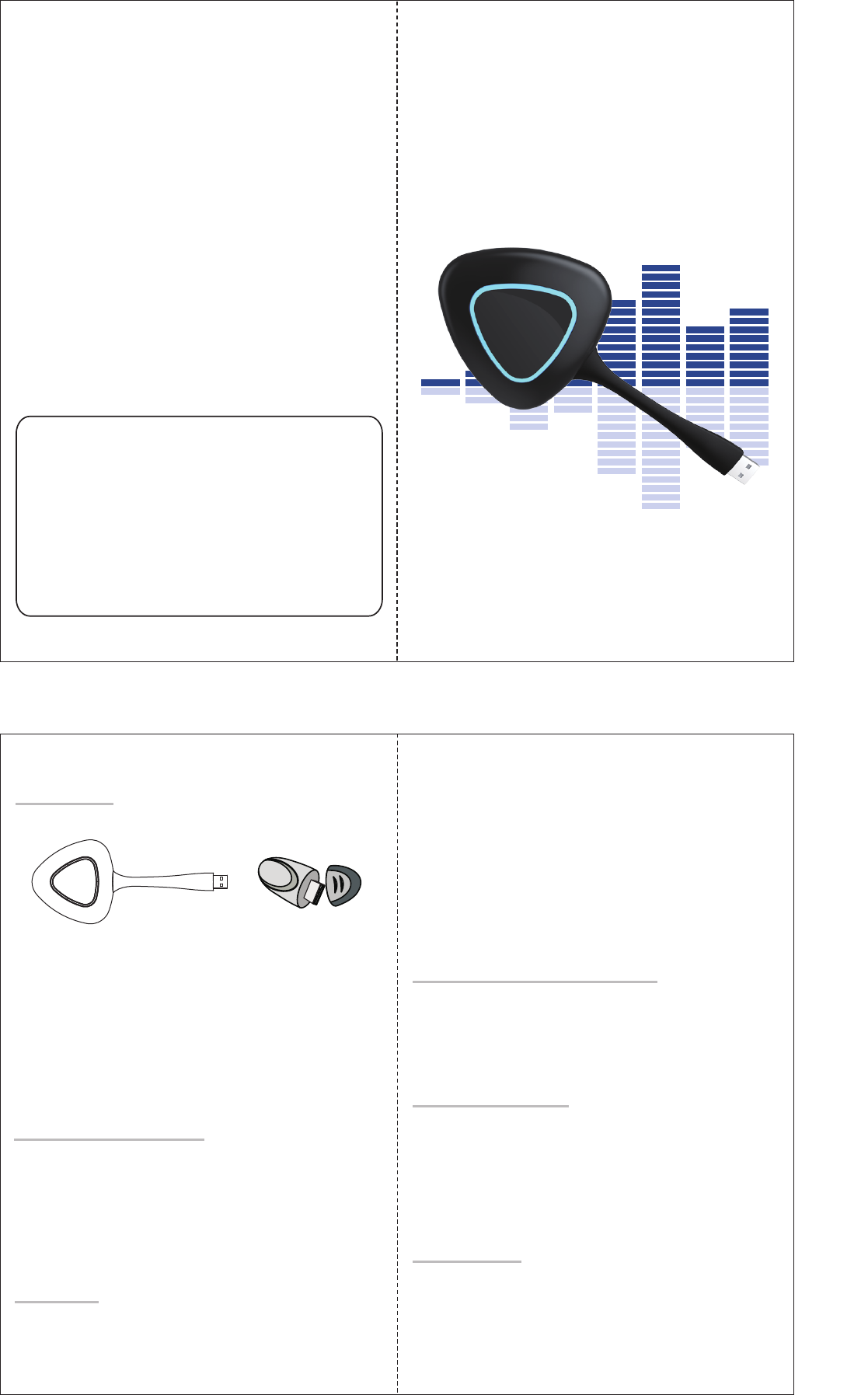Guangzhou Shirui Electronics SM01 Wireless Screen Mirroring User Manual
Guangzhou Shirui Electronics Co., Ltd Wireless Screen Mirroring
Contents
- 1. User manual
- 2. User Manual
User Manual

2. Operation Frequency : 2432MHz&,5180 MHz
Safety Warnings and Precautions
Before using and operating this device, please read thoroughly
and comply with the following precautions in order to prevent
accidents or mal-operations.
Operating Environment
Do not charge or use the device in dusty or wet conditions, to
prevent internal circuit failure.
Keep the device away from heat sources such as an electric heater.
Safety Precaution for Children
This device and its parts may contain some small components,
so keep the product out of reach of children to prevent accidents.
Water Precaution
This device is not water-resistant. Keep it dry.
Maintenance
Please contact professional service personnel for maintenance
services.
Do not insert any sharp or pointed object into the device.
Prevent the device from falls and collisions with other objects,
which may cause damages.
1. Intellectual property right statement: The hardware design
and software of this product are covered by the patents.
Anyone who reproduces this product or the content of the
instruction without the authorization of the Company shall
assume legal liabilities.
2. This instruction is provided for reference onl y , and the functions
shown in the manual may di f fer from the actual functions of the
product the customers actually purchase and receive.
3. The picture is for reference only. Please subject to the actual
product. The Company reserves the rights to improve and
change the appearance and design of the product without
notice.
Wireless Transmitter
Operating Instruction
Connection
Wireless transmitter USB receiver(optional)
Step 1:
First time use: Connect the transmitter and receiver to the USB
ports on your interactive intelligent panel display for pairing (after
then, there is no need to pair again).
Step 2:
After pairing, connect the transmitter to a USB port on your PC;
click to run the Screen Mirroring Software (this is required for the
first time use; after then there is no need to operate again).
Step 3:
Press the button on the transmitter by following the prompts
displayed on your PC to implement screen mirroring.
Basic Troubleshooting
When the systems cannot get connected, please troubleshoot as
follows:
1. Check that the Screen Mirroring Software runs properly on your
PC.
2. Check that the receiver is correctly connected to the interactive
intelligent panel display.
3. Pair the screen mirroring devices again and restart the interactive
intelligent panel display.
Features
1. Mirror your PC's desktop to your interactive intelligent panel
display by connecting the transmitter to your PC and running the
Screen Mirroring Software.
2. Support synchronization of audio and video.
3. Multiple transmitters are in a ready state (support a maximum of
8 transmitters); quickly switch by pressing the button on the
transmitter.
4. Extended screen: The interactive intelligent panel display will be
a extended screen of your PC for contents presentation.
5. Enable touch screen: The Enable Touch Screen allows you to
control your PC by touching the screen, to implement
bidirectional interactions.
Indicators Status Descriptions
1. Blinking: The transmitter is connecting to the interactive intelligent
2. Steady on: The transmitter is connected to the interactive
intelligent panel display and the screening mirroring is set up.
3. Low brightness: Mirroring
Key Specifications
1. Operating systems supported: Win7/Win8/Win8.1/MacOS
3. T ransmission delay: < 120 ms
4. Input power: 5 V -DC
5. Overall power consumption: 2.5 W
6. Overall dimensions ( L x W x D): 77 mm x 178.7 mm x 21.3 mm
Packing List
Wireless transmitter —— 1 pc
USB receiver —— 1 pc (optional)
Operating instruction —— 1 pc
panel display.

The device for operation in the
warning:
This device complies with Part 15 of the FCC Rules. Operation is
subject to the following two conditions: (1) this device may not
cause harmful interference, and (2) this device must accept
any interference received, including interference that may cause
undesired operation.
Changes or modifications not expressly approved by the party
responsible for compliance could void the user's authority to
operate the equipment.
NOTE: This equipment has been tested and found to comply with
the limits for a Class B digital device, pursuant to Part 15 of the
FCC Rules. These limits are designed to provide reasonable
protection against harmful interference in a residential installation.
This equipment generates, uses and can radiate radio frequency
energy and, if not installed and used in accordance with the
instructions, may cause harmful interference to radio
communications. However, there is no guarantee that interference
will not occur in a particular installation. If this equipment does
cause harmful interference to radio or television reception, which
can be determined by turning the equipment off and on, the user is
encouraged to try to correct the interference by one or more of the
following measures:
-- Reorient or relocate the receiving antenna.
-- Increase the separation between the equipment and receiver.
-- Connect the equipment into an outlet on a circuit different
from that to which the receiver is connected.
-- Consult the dealer or an experienced radio/TV technician for
help.
RF Exposure Statement:
FCC RF Radiation Exposure and SAR Statements SAR
Statement The Wireless Screen Mirroring has been tested for
body-worn Specific Absorption Rate (SAR) compliance. The
FCC has established detailed SAR requirements and has
established that these requirements. RF Exposure Information
The radio module has been evaluated under FCC Bulletin OET
65C (01-01) and found to be compliant to the requirements as
set forth in CFR 47 Sections, 2.1093, and 15.247 (b) (4)
addressing RF Exposure from radio frequency devices. This
model meets the applicable government requirements for
exposure to radio frequency waves. The highest SAR level
measured for this device was 0.085 W/kg.
5180 MHz is only for indoor use to reduce
the potential for harmful interference to
co-channel mobile satellite systems.